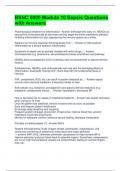BSNC 6000 Module 10 Sepsis Questions
with Answers
Pharmaceutical treatment of inflammation - Answer-antihistamines early on, NSAIDs as
second line, corticosteroids as last resort as they target the entire arachidonic pathway,
inhibiting inflammation but also suppressing the immune system as a whole.
Sepsis is an immune response that progresses from... - Answer-A mild localized
inflammation to a severe systemic inflammation
Symptoms of sepsis can be partially masked with which drugs... - Answer-
Corticosteroids (e.g. prednisone, dexamethasone) blocks arachidonic acid pathway.
NSAIDs block prostaglandin (COX-2 pathway) (but not leukotrienes or plasma-derived
factors).
Antihistamines, NSAIDs, and corticosteroids can help with the damaging effects of
inflammation, essentially "buying time". None deal with the fundamental issue of
infection.
PAF, complement, ROS, etc. can result in positive feedback as... - Answer-sepsis
recruits more chemical mediators, it becomes harder to treat
Both cellular (e.g. histamine, prostaglandin) and plasma-derived mediators (e.g.
bradykinin, complement) induce... - Answer-Vasodilation, decreased BP
How to decrease risk for sepsis in hospitalized patients: - Answer-Use aseptic technique
when caring for IV lines
Once the patient has stabilized, remove invasive lines as soon as possible
Early and frequent patient mobilization
Encourage deep breathing and coughing
Frequent position changes (prevention of bed sores, improve blood flow, prevent
respiratory issues like pneumonia)
Monitor for adequate nutrition (enhance wound healing, decrease metabolism)
Priorities in treating sepsis (7) - Answer-ABCs
Restore hemodynamics: fluids (ringers lactate, plasmalyte), vasopressors, and
continuous monitoring of systems for clues about end-organ perfusion
→ achieve MAP of 65, otherwise administer vasopressor to help increase BP to
improve perfusion and push blood back to essential organs. Sometimes, vasopressors
are run so high that peripheral vessels are compromised, leading to necrotic fingers,
toes, etc.
, → colloid not used in sepsis (large molecules help to retain fluid, but albumin may be
used after fluids given to start process of pulling fluids back into the vasculature)
→ NS ideally not used due to hyperchloremic acidosis, however, use if necessary (too
much sodium bicarbonate in body)
Treat the underlying infection
→ broad spectrum antibiotics (prior to C&S results)
Get the 1 hour bundle started
Reassess continuously!
Update family
Call ICU outreach if worsening assessment findings despite treatment and if BP keeps
dropping despite fluids (septic shock)
When to initiate Sepsis Management: Hour 1 bundle & what are the 5 steps - Answer-
Initiate bundle upon recognition of sepsis or septic shock.
1) Measure lactate level, remeasure if initial is elevated (>2 mmol/L)
2) Obtain blood cultures before administering antibiotics (2 sets, opposite sides)
3) Administer broad spectrum antibiotics
4) Begin rapid administration of 30 mL/kg crystalloid for hypotension or lactate greater
than or equal to 4 mmol/L
5) Apply vasopressors if hypotensive during or after fluid resuscitation to maintain a
mean arterial pressure of greater than or equal to 65 mm Hg.
Sepsis in Bob: case study information - Answer-Bob cannot sustain increased
contractility due to CHF. HR will increase which may be dangerous due to uncontrolled
a-fib, which will lead to decreased BP. However, hold metoprolol because HR needs to
be increased. Neither are sustainable
Cannot improve ventilation due to long term damage to lungs (COPD). This causes
increased pCO2, which will further increase when he is sleepy and unable to maintain
WOB. Thus, only thing left is "composition of inspired air" -> BPAP, CPAP, optiflow?
decreased HgB and decreased RBC... treat through transfusion (PRBC).
oxygen supply kinda crap as a result Lol. therefore, work on oxygen demand. Decrease
temperature, stress, and physical activity.
Draw lactate, blood cultures, and administer abx. Administer fluid bolus despite
CHF/other comorbidites, but we still need to stop his vasodilation. Maybe vasopressors
to get MAP to 65. Intubate, tracheostomy. Diuretic after sepsis clears to get rid of extra
fluids, but cardiomyopathy, liver, and kidney function worse. Catheter to see 30cc per
hour to determine improved perfusion.
Which of the following are true about the inflammatory response?




